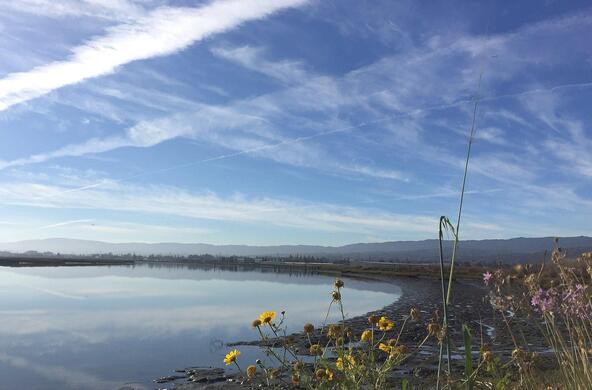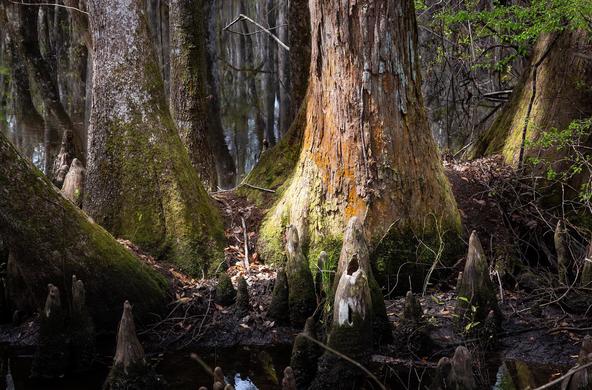Ice cover has been monitored on Mirror Lake in the White Mountains of New Hampshire since 1964 using a protocol set up by Dr. Gene E. Likens, founder and president emeritus of Cary Institute of Ecosystem Studies. Every year, Likens and his assistants record the date of ‘ice-in’, when a complete layer of ice forms on the lake and remains frozen continuously for two days, and ‘ice-out’, when the lake thaws and remains open continuously for two days.
In late 2018, for the first time in the history of this record, Mirror Lake froze for six days, melted fully for five, then refroze until spring. Ice cover on Mirror Lake has become increasingly variable over the past 40 years, and this event supports that trend. It reminds us of the importance of long-term environmental monitoring, without which, we would not be able to identify patterns or anomalies that could point to a bigger problem.
Dr. Likens discusses the Mirror Lake record, what the unusual 2018 ice formation indicates, and why we need long-term environmental monitoring to identify when and how the world is changing.
According to your Mirror Lake ice cover protocol, how do you define 'ice-in' and 'ice-out'?
The day of ice-in is when the lake freezes completely and stays frozen for two days. Ice-out is when the lake thaws completely and does not refreeze for two days. We rely on people on the ground to make these observations. Remote sensing is an important and useful tool in many instances, but ice cover at this scale is something that only a human can reliably discern. It’s very easy for cameras and other sensors to misread reflections from the lake surface.
What was unique about what happened in 2018?
In December 2018, Mirror Lake froze over completely and stayed frozen for six days. It then melted to open water for five days, then refroze. Ice cover that winter lasted from December 4, 2018 through April 26, 2019. In the past, we’ve seen the lake freeze for a day then thaw before freezing fully for the winter. Never before has the lake frozen for multiple days, melted, then froze again.
How are things tracking this year? Was there anything unusual about ice-in 2019? The ice cover formed and stayed. We did have a warm period after it formed and we were watching very carefully to see if the 2018 pattern repeated. But the nights were cold and the ice held. This year is pretty close to being on trend with the long-term record.
What makes the Mirror Lake ice cover dataset unique?
There are many records around the world of ice cover on water bodies that are much longer than the Mirror Lake record. While valuable, these older records were often determined by casual observation, rather than a quantifiable protocol. Scientists use them today to inform research and find patterns, but they aren’t as precise. The Mirror Lake record is unusual because we have followed the same protocol for 52 years.

What did you think when you saw this result?
People who know me know that I'm very fond of saying that my work is dominated by what I call ‘serendipity’. I define serendipity as keeping your eyes, ears, and mind open. When something different or unusual happens, you should jump on it and try to understand what it means. This is a good example of that. It was something that's never happened before in our long-term measurements.
I decided to publish the finding because it’s possible that others around the world have observed a similar occurrence on a water body they’re monitoring, but in searching the literature, have not found any publications reporting similar findings. I published this result so other researchers can see it and make note of it as an example of increasing environmental variability.
What are some examples of ecological processes that are affected by ice cover, and that may be disrupted by increasingly variable freezing patterns?
It's important to measure ice cover on a lake because ice cover is a major feature of the annual thermal budget of a lake.
The most obvious process affected by ice cover is circulation. When the surface of the lake is covered, the wind can't mix surface water into deeper levels. Without mixing, the water column becomes oxygen-depleted.
Light penetration is also important. When a lake is completely frozen and blanketed in snow, it becomes highly reflective and sunlight cannot reach deep into the lake. In open water, sunlight can penetrate and fuel photosynthesis. This is very important, because photosynthesizing organisms comprise the foundation of the lake food web. When photosynthesis does not happen, the food web is affected for all the animals that depend on those photosynthesizing organisms for food.
When a lake freezes, it’s like putting a tablecloth on a kid's play pool. The lake is sealed off from the atmosphere. This affects gas exchange across the water surface. It’s very important that gases like carbon dioxide and oxygen can be exchanged at the lake surface interface. When that exchange is cut off by the ice surface, that affects processes in the lake. One of the ways the lake stays oxygenated is through that exchange of gas at the surface, as well as mixing. When the exchange is cut off, the lake becomes oxygen-poor.
Ice cover on Mirror Lake is becoming unpredictable. Is climate change driving this trend?
Our long-term records show that there's always been variability. For instance, it doesn't always get cold on November 21st. Every year is different. But that variability began to increase dramatically around 1998. Since that year, ice cover formation has fluctuated wildly. The unusual ice formation of 2018 fits in with that increase in variability. What the climate scientists have been saying all along is that climate change is causing this kind of variability all over the world. So is this a feature of climate change? It's difficult to answer that question exactly for one event. But it certainly fits the trend of increased variability.

We need long-term monitoring to detect environmental trends, especially ones that aren't consistent in one direction. What do we have to gain by better understanding environmental variability?
Long-term records of environmental observations are important because they can reveal changes, not just the ones that trend in one direction, but changes like this, which indicate increasing variability over time. This might just be an interesting observation in the long-term record, but that's how science moves forward. You make an interesting observation and you ask the question ‘Why?’. What does this mean? How did it occur? Is it going to occur again?
With acid rain, we first had to determine whether acidic precipitation was unusual to the White Mountains of New Hampshire, or if it was more widespread. Has anybody else ever found this? Where is it coming from? What does it cause environmentally? Does the 2018 ice cover anomaly mean that the ecology of Mirror Lake was different in 2018 than in other years? It raises all those questions.
I think the last sentence in the paper is very important: “This unusual occurrence is another example of the crucial insights provided by long-term data and the critical need to continue such careful monitoring into a period of expected increase in climate variability.”
We must ask questions: Is this likely to continue? Is this likely to change in the future? Exploring those questions will help us develop the long-term perspective needed to find answers.
This paper could be a very important conversation starter.
The Mirror Lake dataset is a very high quality record, so we know it’s a true finding – one which we have never seen before. The import of the discovery of acid rain was the same. The first sample of rain we collected at Hubbard Brook was about a hundred times more acidic than we thought it ought to be. What does that mean? We have the same situation here. We’ve never seen this before. What does that mean? Documenting those kinds of observations in long-term records can help us understand change.
Asking those questions and keeping the records, that's one piece. Communicating it and writing papers like this is also highly important.
It is so important for us to maintain rigorous, long-term records of environmental processes. Right now, some people are arguing about climate change. Scientists are reporting that carbon dioxide levels in the atmosphere have never been higher in the measured record. Temperatures are rising consistently around the world. If those records hadn’t been kept, what evidence would they point to? If naysayers dispute the data, that is a separate issue, but we need the records and we need them to be airtight, to meet the highest scientific standards.
After you published your findings of discovering acid rain in the White Mountains, how long did it take for the world to take notice?
It was a long, slow battle. That first observation was in 1963. We didn't publish the first paper until 1972. It took nine years before we could put together enough information to prepare the work for publication. It was difficult to measure pH at that time. There weren't pH meters like there are now. We published the second paper in 1974, 11 years after the discovery, in Science where we argued that acid rain wasn't just something unusual happening at Hubbard Brook; it was a regional issue. I had set up precipitation collectors in the Finger Lakes region of New York to test this and found that precipitation was highly acidic there too.
The paper in Science made the front page of the New York Times. There were a lot of naysayers then, just like climate change deniers today. In Australia, the government and some media outlets are saying that the fires there are caused by arson. That does not make sense. The fires are a result of severe and prolonged drought, paired with the intense heat of the summer season – all exacerbated by climate change. The idea that it’s primarily caused by arson is clearly false. There are many thin, baseless arguments, yet they're often loud and showy, so they get media coverage and people believe them.
We're in a period of science denial. We're in a period where lying is the way to get ahead. People believe talk radio. People believe misinformation reported on social media and the internet. That’s one of the reasons why I published this little paper. It describes something unusual that I found in my research extending back more than five decades. So I thought it was very important to make this information known and available. I like the word unusual because it’s descriptive, but it's not alarmist. It's not taking a position. It's just saying that the finding is unusual based on long-term measurement. It's different. I can say scientifically, with stated uncertainties, that this event is unusual. And unusual findings should not be ignored.
In this moment wherein science is so under attack, what is your advice to scientists with regard to communication?
We scientists must speak out about things we know about. And I think we need to do a much better job of speaking and communicating more clearly. We use too much jargon, too many acronyms.
We have to fight back against attacks that suggest we publish disturbing findings just to get more funding. That was a criticism I heard when we published our findings about acid rain, and it’s what climate scientists are facing now. People think you publish something alarming because it's going to help attract funding. I, for one, don't get any major funding at this stage of my career. This particular paper, you might say, is the result of a long-term hobby. I didn’t receive one penny to write this paper.
I think we need to be much clearer about our work, its importance, and why we’re pursuing it. Scientists, especially young scientists, are anxious about communicating in the media. I think they're frightened because it's scary to go in front of a reporter, and especially to go in front of a live television camera. When that red light goes on at the camera, that’s scary. You can't say, “Oh no, I mis-spoke. What I said was confusing. No. Turn it off, take it off the record.” That's exactly the part they will air.
And of course, as a scientist, you like to think that your work has value. Many scientific papers don’t get covered in the media. They’re put on shelves and never looked at again. So if you write a paper like I did on acid rain and it gets published in Science, then soon after, it’s on the front page of the New York Times, that’s good, but it’s rare. And when you speak to reporters, you do open your work to potential misinterpretation. That’s worrying. But if scientists let this risk prevent them from speaking out, how will the world learn about important findings? Science needs to be communicated to move forward.
Not long after the acid rain research was published, I gave a lecture on the topic at the University of California, Davis. I didn't know there was a reporter in the audience. The next day in the Sacramento Bee, the main political paper in California, there was a headline that said ‘Prof says rain on acid trip’. It was a very effective headline because that was the time of psychedelic drugs. Of course, those were not my words and it wasn’t the right context, but it caught public attention.
Was the article itself accurate?
Yes, the piece itself was fine. The acid trip headline attracted a lot of attention, so people read the story about acid rain. It was flashy, and not something we would publish in Science, but it worked for the newspaper. People learned about the problem of acid rain.
Flashback 1988
The Global Environment: Are We Overreacting?
Gene E. Likens participated in a 1988 forum on 'Pollution, Waste, and Toxics' sponsored by the Smithsonian Institute. His presentation on toxic winds, air pollution, and acid rain emphasizes the importance of communicating science to the media.







